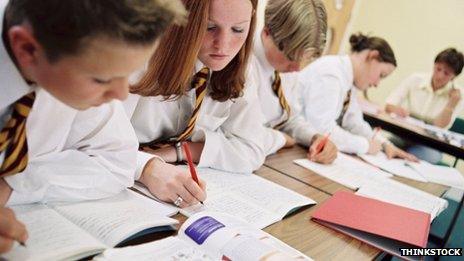Secondary place crunch 'to hit a third of councils'
- Published

The school place crunch is starting to move into secondary schools
Urgent action is needed to prevent a shortage of secondary school places in a third of local authorities in England within five years, councils say.
The latest predictions suggest 49 out of 152 councils will have more pupils than secondary places by 2019-20.
Local Government Association analysis of official figures suggests 80,716 new secondary places will be required then.
The Department for Education says it has provided local authorities with the funding they need for new places.
It added: "It is now up to them to spend this money efficiently and effectively."
But the LGA said the crunch in primary schools meant that despite the creation of nearly 90,000 places in the past academic year, and the government committing £2.35bn in places funding for up to 2017, an extra 130,000 were needed before September 2017.
Councils were already taking extraordinary measures to deal with the school places crisis, it said. One borough council, Reading, borrowed £35m privately to fund the expansion of 13 of its primary schools.
Essex County Council topped up its government grants with £39m from its own resources while others have expanded existing schools on to second sites or "annexes" to create the places needed.
David Simmonds, chairman of the LGA's children and young people board, said: "As children move through primary school, securing new secondary places will become a significant issue.
"Mums and dads should know councils will do everything they can to create more school places and there are great examples of the work being done across the country.
"The challenge for councils is making sure places are delivered on time and in the right places, in a context where some of the decision making about new school places is now in the hands of the government."
'Bussing children'
There is a presumption that new schools will be free schools or academies, which are outside local authorities' sphere of influence. It means local authorities do not have as much control over the creation of new schools and places as they once did, although they can invite bids for free schools and academies in their areas.
In a report for the LGA on the planning of school places, Mr Simmonds added: "There are real concerns that the 'easier solutions' have now been taken in the primary sector and dealing with the surge in demand for secondary school places will become more costly and complex.
"Councils are now looking to innovative solutions, with Surrey looking to drive down costs by working in a property cluster with neighbouring authorities.
"Bournemouth is considering the idea of village schools in former church halls or day centres. Less palatable solutions are also being contemplated, such as bussing children to different areas, building on split sites and even building on the green belt."
The secondary school places shortage is just a few months a way in a handful of local authorities.
In September, three local authorities will be over capacity; by 2015-16 it will be six and 36 in 2018-19.
Councils are calling for information on school building funding in five-year cycles and for it to be in one funding pot.
'Resources wasted'
They would also like to see the decision-making power on the provision of schools, including free schools, restored to local authorities, along with the power to open council-controlled community schools.
A Department for Education spokesman said: "We are giving local authorities £5bn to spend on new school places over this Parliament - double the amount allocated by the previous government over an equivalent period.
"This funding has already led to the creation of 260,000 new school places, all of which are in areas where there is a shortage of places, and many more new places are planned. We have also confirmed a further £2bn for basic need up to 2017."
He added: "Investment in free schools comes on top of the £5bn we are giving to local authorities to spend on basic need. Seven in 10 free school places are in areas of basic need."
Natalie Evans, director of the New Schools Network, which supports the creation of free schools, said: "Over two-thirds of free schools are being set up in areas where there is a shortage of school places and local authorities themselves are able to invite groups to come forward to set up new schools where that shortfall is particularly acute.
'Complacency'
"There are many good examples of local authorities working in partnership with groups setting up free schools, but too often authorities perceive these schools as a threat and end up being an unnecessary obstruction to a solution which would work for all."
Kevin Brennan, shadow schools minister, said: "David Cameron's government has displayed a shocking degree of complacency in responding to the need for new school places."
He claimed two-thirds of all places created by the free schools programme were being diverted away from areas of high or severe need.
Christine Blower, general secretary of the National Union of Teachers, said: "Local councils find themselves having responsibility for providing places but with insufficient powers to plan, commission or build schools."
- Published14 March 2014
- Published3 September 2013
- Published15 March 2013